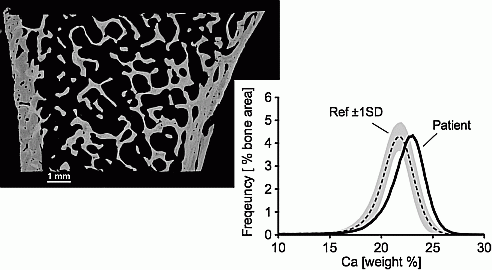ICCBH2015 Oral Communications (1) (22 abstracts)
Increased bone matrix mineralization in treatment-naive children with Crohn's disease
Paul Roschger 1 , Barbara Misof 1 , Klaus Klaushofer 1 , Frank Rauch 2 & Leanne Ward 3
1Ludwig Boltzmann Institute of Osteology at the Hanusch Hospital of WGKK and AUVA Trauma Centre Meidling, 1st Medical Department, Hanusch Hospital, Vienna, Austria; 2Department of Pediatrics, McGill University, Shriners Hospital of Montreal, Montreal, Canada; 3Department of Pediatrics, University of Ottawa, Children’s Hospital of Eastern Ontario, Ottwa, Canada.
Background: Crohn’s disease (CD) is an inflammatory bowel disease which affects many organ systems including the skeleton. In children with CD, bone mineral density is frequently low. Bone metabolic abnormalities, including lower biochemical measures of bone turnover (NTX) as well as decreased bone formation indices at the tissue level have been reported. The aim of our study was to gain information on the bone matrix mineralization in CD.
Methods: We studied the bone mineralization density distribution (BMDD) based on quantitative backscattered electron imaging (qBEI) in cancellous (Cn.) and cortical (Ct.) compartments from trans-iliac biopsy samples from 20 treatment-naïve children with CD at the time of diagnosis (eight females/12 males, mean age 14.5±2.3 years). The outcomes were compared to healthy reference BMDD data (n=54).
Results: The BMDD of the untreated patients with CD was shifted toward higher calcium concentrations compared to normal (Figure). In cancellous bone, we found the most frequent calcium concentration (Cn.CaPeak +2.8%, P=0.004) and the portion of highly mineralized bone areas (Cn.CaHigh +52%, P=0.009) increased compared to the reference cohort. In cortical bone, indices of mineralization heterogeneity (Ct.CaWidth +17.0%, P=0.001) and Ct.CaHigh (+30.4%, P=0.006, median comparison) were increased. Significant correlations with serum alkaline phosphatase (ALP) and urinary crosslinked N-telopeptide of type I collagen (NTX) were observed: CaMean (the average calcium concentration), CaPeak and CaHigh were decreased (Spearman rank order correlation coefficients R ranging from −0.69 to −0.47, P value from <0.001 to 0.05), while CaWidth and CaLow (the percentage of low mineralized bone areas) from both cancellous and cortical compartments were high (R from 0.45 to 0.65, P<0.05 to P<0.01) with increasing levels of ALP and NTX.
Conclusions: The significant correlations of cancellous and cortical BMDD parameters with ALP and NTX reflect a general dependency of the bone matrix mineralization measured at the iliac crest on bone turnover. The shift toward higher bone matrix mineralization density compared to reference is consistent with the decreased bone formation indices reported for these untreated children with CD.
Disclosure: The authors declared no competing interests.

Figure 1




